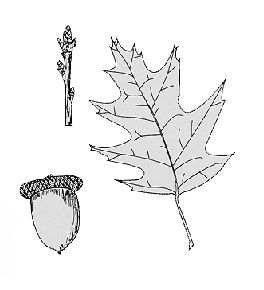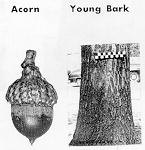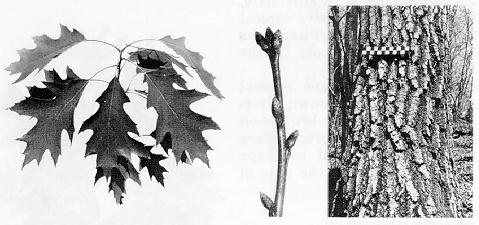Quercus rubra
 The red
oak is one of the largest and most important timber trees. One of the fastest growing of the oaks,
it attains a to 80 feet and a diameter of two to three feet. It has a wide, spreading head with few
far reaching branches. Found growing over southeastern Canada and the northeastern United States,
it reaches west to central Minnesota, eastern Nebraska and Kansas. It is found over most of Iowa on
a variety of soils, except on the drier clay uplands. It prefers moist, rich soils on north, east
or northeast exposures.
The red
oak is one of the largest and most important timber trees. One of the fastest growing of the oaks,
it attains a to 80 feet and a diameter of two to three feet. It has a wide, spreading head with few
far reaching branches. Found growing over southeastern Canada and the northeastern United States,
it reaches west to central Minnesota, eastern Nebraska and Kansas. It is found over most of Iowa on
a variety of soils, except on the drier clay uplands. It prefers moist, rich soils on north, east
or northeast exposures.
 The tree has
a single, lobed leaf with seven to eleven pointed or bristly-tipped lobes. The lobe sinuses reach
one-half way to mid-vein. The leaves are thin, firm, dull green above, yellow-green below, varying
considerably.
The tree has
a single, lobed leaf with seven to eleven pointed or bristly-tipped lobes. The lobe sinuses reach
one-half way to mid-vein. The leaves are thin, firm, dull green above, yellow-green below, varying
considerably.
The fruit is a large, broad, rounded acorn with a very shallow disk-like or saucer-shaped cup or cap.
The twigs are small, slender, greenish brown to dark brown. On young branches the bark is smooth and gray to greenish. On the trunk it breaks into long, narrow, shallow ridges flat and smooth on top. The underbark is light red.
Leaves:
- Have seven to 11 toothed lobes that are separated by sinuses extending about halfway to the midrib.
- Contain tannin, a substance that makes the leaves leathery and hinders decomposition.
- Dark red, fading to brown but may remain on the tree well into the fall.

Branching: alternate
Bark: reddish brown when young; mature tree is dark, furrowed and often laced with broad shiny strips (ski trails).
Height: 70 to 90 ft.
Trunk Diameter: 2 to 4 ft.
Longevity: 300+ yrs.
Tolerance: intermediate
Range: eastern U.S. except for the south Atlantic and Gulf Coastal Plains
Fun Facts: Acorns provide a food source for numerous birds and animals: Ruffed grouse, nuthatch, blue jay, wild turkey, red, gray and fox squirrels, bears, deer, raccoons.
- Question: How many root beer barrels could you make from a red oak tree?
- Answer: None - red oak has big pores, so all the root beer would leak out.
![]()